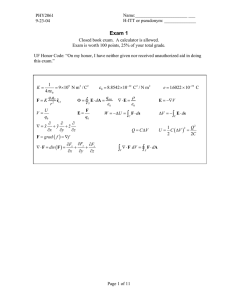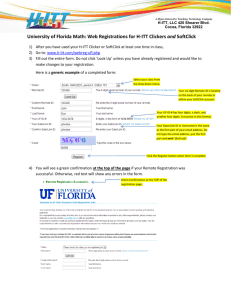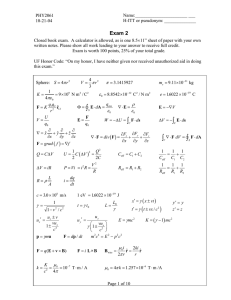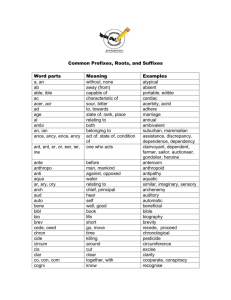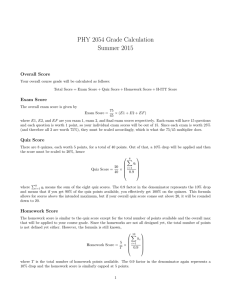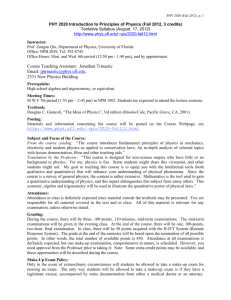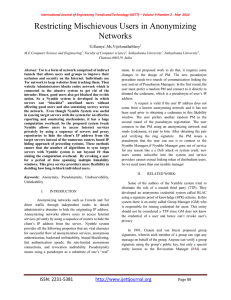Exam 1 Solution
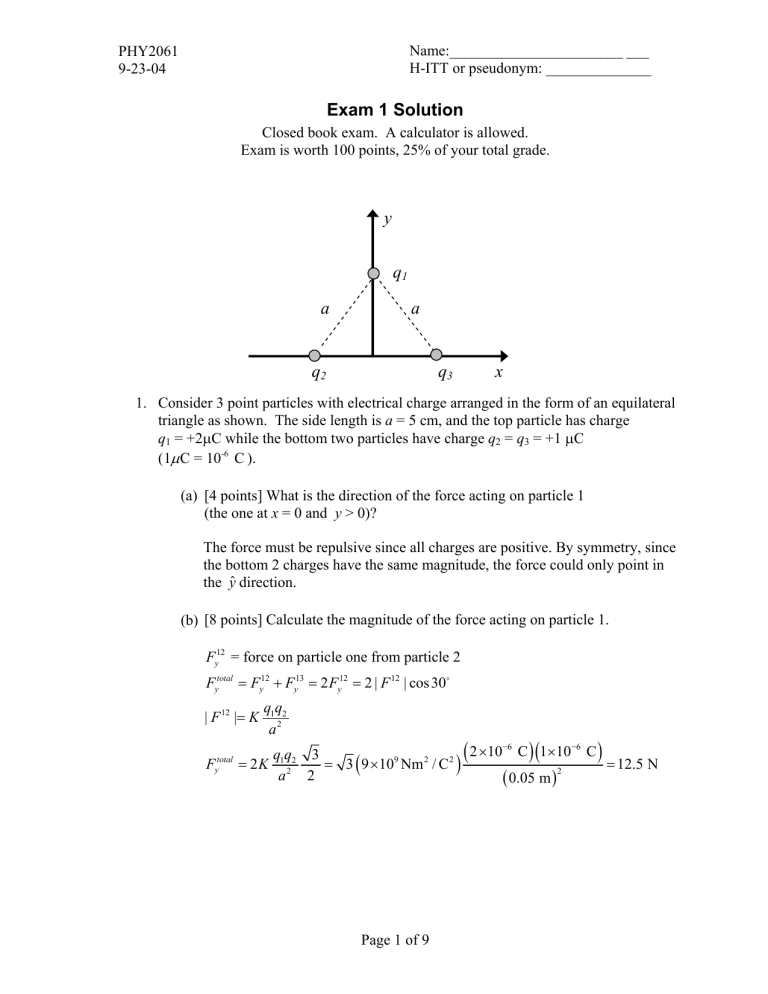
PHY2061
9-23-04
Name:_______________________ ___
H-ITT or pseudonym: ______________
Exam 1 Solution
Closed book exam. A calculator is allowed.
Exam is worth 100 points, 25% of your total grade. y a q
1 a q
2 q
3 x
1.
Consider 3 point particles with electrical charge arranged in the form of an equilateral
( triangle as shown. The side length is a = 5 cm, and the top particle has charge q
1
= +2
µ
C while the bottom two particles have charge q
2
= q
3
= +1
µ
C
µ
-6
1 C = 10 C ).
(a) [4 points] What is the direction of the force acting on particle 1
(the one at x = 0 and y > 0)?
The force must be repulsive since all charges are positive. By symmetry, since the bottom 2 charges have the same magnitude, the force could only point in the y direction.
(b) [8 points] Calculate the magnitude of the force acting on particle 1.
F y
12 = force on particle one from particle 2
F y total =
F y
12 +
F y
13 =
2 F y
12 =
F
12
2 | | cos 30
D
| F 12 |
=
K q q
1 2 a 2
F y total =
2 K q q
1 2 a 2 2
3
=
(
× 2 2
)(
−
6
)(
(
0.05 m
)
2
−
6
)
=
12.5 N
Page 1 of 9
PHY2061
9-23-04
Name:_______________________ ___
H-ITT or pseudonym: ______________
1. Continued:
(c) [6 points] Calculate the electric field at the location of particle 1 arising from particles 2 and 3 ?
E
=
F
= q
1
−
6
(d) [6 points] Does a position exist where a fourth charge can be added to put the triangle in electrostatic equilibrium? If so, sketch where it would lie approximately, and write down an equation for its charge in terms of: the distance d from particle 1, the side length a , and the magnitude of the other charges (in other words, you don’t have to solve for d ).
Yes, add a negative charge inside triangle to pull charges back together. By symmetry, it will lie along y axis. Let’s solve for the total force acting on particle
1 to be zero, letting d be the distance from particle 1 on the y axis:
F y total =
F y
12 +
F y
13 +
F y
14 =
0
⇒ q
4
F
14
= −
=
K q q
1 4 d
2
3 d 2 a
2 q
2
= −
( F y
12 +
F y
13
)
= −
3 K q q
1 2 a
2
Page 2 of 9
PHY2061
9-23-04 y
Name:_______________________ ___
H-ITT or pseudonym: ______________
R x
2.
Consider electric charge distributed along a one-dimensional path in the form of a semi-circle with radius R = 5 m in the upper two quadrants of the x-y plane as shown.
The semicircle has a center at (x, y) = (0,0) and has a linear charge density of
λ
=
+2
µ
C/m.
(a) [6 points] Find component of the electric field along the x -axis (E x
) at the origin (0,0).
= 0 (each side of semi-circle cancels out) explicitly sin
θ below.
(b) [6 points] Find component of the electric field along the y -axis (E y
) at the origin (0,0).
Field points away from the positive line charge, so in ˆ direction. dq
= λ ds
= λ θ dE
E y y
= −
= −
∫
0
π dq
K
2 sin
R
λ sin
R
2
θ
E y
= −
2
λ
K
R
= −
(
=
λ
K
R
−
6
θ π
0
5 m
)(
9
)
= −
7200 N/C
Page 3 of 9
PHY2061
9-23-04
Name:_______________________ ___
H-ITT or pseudonym: ______________
2. Continued:
(c) [6 points] If a semi-circle is added to the lower two quadrants ( y < 0, with the center at the origin again) with a linear charge density of equal magnitude but opposite sign to the upper semicircle (i.e.
−
2
µ
C/m), calculate the total E x
and
E y
at the origin again arising from both semicircles.
Field lines point toward negative charge, so in same direction as from upper semi-circle of positive charge. By symmetry, field strength doubles. integrating
π
to 2
π
in previous problem.
E y
= −
4
λ
R
K
= −
14400 N/C
Page 4 of 9
PHY2061
9-23-04 y
Name:_______________________ ___
H-ITT or pseudonym: ______________ x z
3.
Consider a cube with side length s = 3.0 m and one corner at the origin (0,0,0) as shown.
(a) [6 points] What is the total electric flux emanating out through the surface of the cube if the electric field is
E = the z-direction.)
The electric field points in the z direction. The only faces that will possibly contribute flux are the ones at z =0 and z=s , since
⋅ =
for the other faces.
Φ = v ∫
S
E A = ∑ i
Ε A Ε
( z
)
Ε
( z
)
Φ = −
15 s
2 +
15 s
2 =
0
A
In other words, the net flux through the cube’s surface for a constant field is zero. You could also use the differential form of Gauss’ Law:
∇ ⋅ =
ε
ρ
0
=
0 since the electric field is a constant.
Thus, the total charge enclosed is zero, and so by the integral form of Gauss’
Law the flux must sum to zero.
(b) [6 points] What is the total electric flux emanating out through the surface of the cube if the electric field is
E =
(
5 x
2 +
15 z z
)
N/C-m ?
Now we have two components of the field, so 4 faces contribute:
Φ = ∑
Ε A Ε i
⋅ = ( z
)
1 2 s s
A Ε
( z s
)
A Ε
( x
)
Ε
( x
)
2 2 s s
= 2
810 N m / C
A
Page 5 of 9
PHY2061
9-23-04
Name:_______________________ ___
H-ITT or pseudonym: ______________
3. Continued:
(c) [6 points] What is the total charge enclosed by the cube if the electric field is the same as in part (b)?
Φ = q enc
ε
0
⇒ q enc
=
(
2
)(
× −
12 2
C /Nm
2
)
= × −
9
(d) [6 points] What is the electric charge density at the center of the right face at x
= 3.0 m if the electric field is the same as in part (b)?
ρ ε
ε
ρ
0
∂
E x
∂ x
Gauss' Law in differential form
+
∂
E y
∂ y
+
∂
E z
∂ z
= ⋅ x
+
15
=
45 at x
=
3
E × −
9
0.4 10 C/m
3
Page 6 of 9
PHY2061
9-23-04 y
Name:_______________________ ___
H-ITT or pseudonym: ______________ b a x
4.
A very long cylinder (length L = 5 m) carrying a total electric charge of +5
µ
C distributed uniformly along its length is surrounded by a concentric cylindrical shell with a total charge of
−
2.5
µ
C distributed uniformly along its length as shown. The radius of the inner cylinder is a = 0.005 m and the radius of the outer cylinder is b =
0.01 m.
(a) [6 points] What is the electric field strength and direction between the two cylinders ( a<r<b ) ?
Radial field lines by symmetry. Apply Gauss’ Law:
Φ = v ∫
S
E A = q enc
ε
0
2
π rLE r
E r
= q a
ε
0
= q a
2
πε
0
1
L r
=
2 K q a
L r
1
=
(
× 9
) 5 10 C 1
5 m r
=
× r
4
N /C
(b) [6 points] What is the electric field strength and direction outside the outer cylinder ( r>b ) ?
Φ = v ∫
S
2
π rLE r
E A
=
= q a
+ q b
ε
0 q enc
ε
0
E r
= q a
+ q b
2
πε
0
1
L r
=
2 K
( q a
+ q b
) 1
L r
=
(
× 9
) 2.5 10
5 m
−
6 C 1 r
=
× r
3
N/C
Page 7 of 9
PHY2061
9-23-04
Name:_______________________ ___
H-ITT or pseudonym: ______________
5.
[4 points] The figure below shows an object made of an electrically conductive material with a total electrical charge + Q deposited on it. Sketch the electric field lines and equipotential lines near the surface of the object.
Near the surface of a conductor, the field lines must be perpendicular to the surface
(otherwise charges would accelerate). The equipotential lines must be perpendicular to the field lines, and thus parallel to the surface. Finally, the field strength is largest near small sharp places.
One potential line and several field lines are sketched below:
Page 8 of 9
PHY2061
9-23-04
Name:_______________________ ___
H-ITT or pseudonym: ______________
6.
The surface of a conducting sphere of radius 5 cm is at a potential of 450 V with respect to the potential at infinity.
(a) [6 points] What is the electric charge density on the surface of the sphere?
The electric field outside of a sphere is the same as that for a point charge.
V
=
K
Q
=
VR
=
K
σ =
Q
=
S
Q
since we assume V
( )
0
R
(
450 V
)(
0.05 m
)
× 2 2
−
9
4
π
R
2
=
2.5 10 C
= × −
8 2
(b) [6 points] What is the strength of the electric field at a distance of 10 cm above the surface of the sphere?
10 cm above the sphere is 15 cm away from the center.
E
=
K
E
Q
R
2
=
1000 N/C
2 2
)
0.15
−
9
2
(c) [6 points] If another sphere is brought in with a potential of
−
450 V at its surface with respect to infinity, what is the capacitance of the two-sphere system?
We have 2 conductors, one with +Q charge and one with –Q charge, equal and opposite because they have equal and opposite electric potentials with respect to infinity. They have a potential difference between them:
V 450
− (
450
) =
900 V
Treating this as a capacitor:
Q C V C
∆
Q
V
=
−
9
900 V
= −
12
2.78 10 F = 2.78 pF
Page 9 of 9
